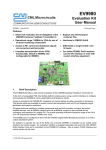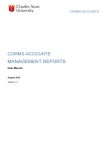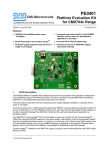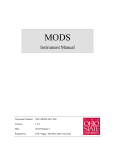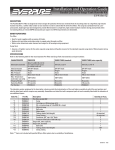Download EV9930 Evaluation Kit User Manual
Transcript
EV9930 CML Microcircuits Evaluation Kit User Manual COMMUNICATION SEMICONDUCTORS UM9930/1 November 2008 Provisional Issue Features • Operational range: 100MHz to 1GHz • Allows full evaluation and investigation of • the CMX993 quadrature modulator • Access to RF, control and baseband signals via connectors and test points 1 • • Interfaces to CMX910 or CMX981 EvKit Differential or single-ended I and Q inputs Can utilise PE0002 EvKit interface card for PC interface or work with custom interface equipment Brief Description The EV9930 EvKit allows for rapid and full evaluation of the CMX993 Quadrature Modulator IC by providing a populated pcb with access to all CMX993 RF, baseband and control signals by either connectors or test points. Test access points are available to accept common test equipments such as RF and baseband signal generators and spectrum analysers. Control of the CMX993 is by registers which are accessible over the C-BUS interface (an SPI™-like serial interface). A PE0002 Interface Card (not supplied) allows the C-BUS interface to be controlled from a PC, via its USB port. Alternatively, the C-BUS interface can be controlled by an external microprocessor. RF signal paths are matched by suitable components and the operating frequency range of the EvKit is for RF frequencies between 100MHz and 1GHz. The EV9930 baseband inputs can be configured to work with the CMX910 AIS Baseband Processor IC or the CMX981 Digital Radio Baseband Processor IC; standard test equipment or with a custom baseband system. © 2008 CML Microsystems Plc Evaluation Kit for CMX993 EV9930 CONTENTS Page Section 1 Brief Description .................................................................................................1 2 Preliminary Information......................................................................................5 2.1 Laboratory Equipment..............................................................................5 2.1.1 Power Supply..............................................................................5 2.2 Handling Precautions...............................................................................5 2.2.1 Static Protection..........................................................................5 2.2.2 Contents - Unpacking .................................................................5 2.3 Approvals .................................................................................................5 3 Quick Start ...........................................................................................................6 3.1 Make External Connections and Apply Power ........................................6 3.2 Typical Configure .....................................................................................7 3.3 Operate ....................................................................................................7 4 Signal Lists ..........................................................................................................8 5 Circuit Schematics and Board Layouts..........................................................12 6 Detailed Description .........................................................................................14 6.1 Hardware Description ............................................................................14 6.1.1 Quadrature (I/Q) Modulator ......................................................14 6.1.2 Local Oscillator (LO) .................................................................14 6.1.3 I/Q Baseband Inputs .................................................................14 6.1.4 Differential I/Q Interface ............................................................14 6.1.5 Power Supply............................................................................14 6.2 Software Description..............................................................................15 6.2.1 The ‘CMX993 Regs ($02 - $08)’ Tab........................................15 6.2.2 The Script Handler Tab.............................................................15 6.3 Application Information ..........................................................................17 6.3.1 Typical Performance .................................................................17 6.4 Troubleshooting .....................................................................................19 7 Performance Specification...............................................................................20 7.1 Electrical Performance...........................................................................20 7.1.1 Absolute Maximum Ratings ......................................................20 7.1.2 Operating Limits........................................................................20 7.1.3 Operating Characteristics .........................................................21 © 2008 CML Microsystems Plc 2 UM9930/1 Evaluation Kit for CMX993 EV9930 Table Table 1 Table 2 Table 3 Table 4 Table 5 Table 6 Table 7 Page Quick-Start Signal Configuration ....................................................................................... 7 Signal List........................................................................................................................... 8 C-BUS 2 Interface.............................................................................................................. 9 C-BUS 1 Interface (for PE0002) ...................................................................................... 10 Test Loops ....................................................................................................................... 11 Test Points ....................................................................................................................... 11 Possible Errors................................................................................................................. 19 Figure Figure 1 Figure 2 Figure 3 Figure 4 Figure 5 Figure 6 Page Block Diagram .................................................................................................................. 4 Typical Evaluation Connections for EV9930 .................................................................... 6 PCB Layout: top.............................................................................................................. 12 PCB Layout: bottom........................................................................................................ 13 The ‘CMX993 Regs ($02 - $08)’ Tab.............................................................................. 15 0dBm Output Power at 450MHz with APCO C4FM Modulation .................................... 19 It is always recommended that you check for the latest product datasheet version from the Datasheets page of the CML website: [www.cmlmicro.com]. © 2008 CML Microsystems Plc 3 UM9930/1 Evaluation Kit for CMX993 EV9930 CMX910/CMX981 I/Q Interface KEY Interface Connector Differential I/Q Coax Connector RFOUT External I/Q Inputs CMX993 C- BUS Interface LO-IN Figure 1 Block Diagram © 2008 CML Microsystems Plc 4 UM9930/1 Evaluation Kit for CMX993 2 EV9930 Preliminary Information The EV9930 provides a platform for the evaluation of the CMX993. To use the EV9930, a separate micro-controller or PC is required to program the CMX993 via its C-BUS interface. This controlling device is not included on the EV9930, but a PE0002 Interface Card (not supplied) will provide the controlling functionality from a PC, via its USB port. 2.1 Laboratory Equipment The following laboratory equipment is needed to use this evaluation kit: • • • • Power Supply (Dual Power Supply if using PE0002). Spectrum Analyzer (100MHz to 1GHz) RF Signal Generator (100MHz to 2GHz) I/Q Quadrature Signal Source For more detailed design or investigation work the customer may require other RF test equipment. 2.1.1 Power Supply The supply input voltage to the PCB is 5.0V (4.0V to 8.0V acceptable). An on-board regulator is provided to generate the power supplies used on the PCB. The 5.0V supply should be rated at >200mA. NOTE: Care should be exercised with the supplies, as they are not protected for reverse polarity. NOTE: When using the EV9930 kit with a PE0002 kit, power is not supplied to the PE0002 via the C-BUS connector (J2). The PE0002 must be connected directly to a separate 5Vdc regulated power supply. 2.2 Handling Precautions Like most evaluation kits, this product is designed for use in office and laboratory environments. The following practices will help ensure its proper operation. 2.2.1 Static Protection This product uses low power CMOS circuits that can be damaged by electrostatic discharge. Partially damaged circuits can function erroneously, leading to misleading results. Observe ESD precautions at all times when handling this product. 2.2.2 Contents - Unpacking Please ensure that you have received all of the items on the separate information sheet (EK9930) and notify CML within 7 working days if the delivery is incomplete. 2.3 Approvals This product is not approved to any EMC or other regulatory standard. Users are advised to observe local statutory requirements, which may apply to this product and the radio frequency signals that may emanate from it. © 2008 CML Microsystems Plc 5 UM9930/1 Evaluation Kit for CMX993 3 EV9930 Quick Start This section provides instructions, in three main steps, for users who wish to experiment immediately with CMX993 evaluation. A more complete description of the kit and its use appears later in this document. The EV9930 includes a CMX993 device that is described in its own, separate, datasheet. Accordingly, before using the EV9930 the user should read the current CMX993 datasheet. 3.1 Make External Connections and Apply Power In this first step external connections are made to the EV9930 and then power is applied. Perform the following steps in sequence: 1. Connect test leads as shown below in Figure 2. 2. Connect a host µController to C-BUS interface J1 or J2 (alternatively, the CML PE0002 card). 3. Power should be applied to the main supply (5.0V nominal). J1 J3 GND +5.0V RF Signal Generator J2 J4 - CMX993 LO_IN J5 - J6 - TXI EV9930 TXQ J7 J8 RFOUT Baseband IQ Generator - RF Spectrum Analyser Figure 2 Typical Evaluation Connections for EV9930 © 2008 CML Microsystems Plc 6 UM9930/1 Evaluation Kit for CMX993 3.2 EV9930 Typical Configure In this second step the EV9930 is configured as follows: • • With a single-ended I/Q baseband, input signals at 0V DC bias. With an LO signal applied to give an RF output at 450MHz. Apply signals and set register values as per Table 1. Program the CMX993 registers by use of a host µcontroller or PE0002 Interface Card, connected as per section 3.1 step 2. The CMX993 datasheet gives details of the registers and commands. These can be set directly in the "C-BUS Control" tab of the ES0002xx.EXE software, which forms part of the PE0002 kit. Signal or Register Setting LO input 900MHz at –10 dBm J4 I/Q baseband inputs 0V DC J5, J6 General Control register ($02) Set the CMX993 General Control register bits 0 and 1 to their normal operating state (set both to ‘0’) and enable all of: • Modulator and LO ccts • Bias circuits • Filter amplifiers • Input amplifiers Forward path gain control register ($05) Frequency Control register ($08) Note Connector This frequency is twice the RF output frequency that will be developed These inputs must be connected to 0V DC; do not leave them unconnected or open circuit 0 dB This means the externally applied LO must be twice the desired RF carrier frequency Divide by 2 mode (b4 cleared to ‘0’) Table 1 Quick-Start Signal Configuration 3.3 Operate Baseband I/Q signals (typically 700mV to 1.0V pk-pk) can now be applied to develop a modulated RF output of ~ +3dBm PEP. Notes: a) b) The output of the CMX993’s input amplifiers should be 0.35V pk-pk nominal and 0.5V pk-pk maximum. Any user changes to the input amplifier’s external components and applied baseband I/Q signal levels should ensure the signal applied to the CMX993 modulator inputs MODQP / MODQN / MODIP / MODIN remain within the specified range. The peak to average power ratio of the user-provided modulation will determine the mean RF output power delivered by the EV9930. © 2008 CML Microsystems Plc 7 UM9930/1 Evaluation Kit for CMX993 4 EV9930 Signal Lists CONNECTOR PINOUT Connector Ref. Connector Pin No. Signal Name Signal Type Description J1 1 - 10 C-BUS 2 Interface Logic Alternative header for C-BUS interface J2 1 - 20 C-BUS 1 Interface Logic C-BUS interface from PE0002 or host / controller PC. See schematics and CMX993 datasheet for details. J3 2 +5.0V DC 5.0V power supply input J3 1 GND DC Power supply ground J4 N/A LO-IN RF LO input can be applied at 2 x RF output frequency or 4 x RF output frequency. Nominal input level is -10dBm. J5 N/A TXQ Baseband Q input signal (non-inverting input of input amplifier) J6 N/A TXI Baseband I input signal (non-inverting input of input amplifier) J7 1, 2, 4, 5 TXQ+, TXQTXI-, TXI+ Baseband Differential I/Q input from the CMX981 evaluation board J7 3 GNDA Baseband Connection to analogue ground J8 N/A RFOUT RF Modulator RF output Table 2 Signal List © 2008 CML Microsystems Plc 8 UM9930/1 Evaluation Kit for CMX993 EV9930 CONNECTOR PINOUT for J1 Connector Pin No. Signal Name Signal Type Description 1 CSN I/P C-BUS enable 2 ~ ~ Spare pin. Leave unconnected 3 S_DATA_IN I/P C-BUS data input 4 ~ ~ Spare pin. Leave unconnected 5 S_CLOCK I/P C-BUS clock 6 ~ ~ Spare pin. Leave unconnected 7 ~ ~ Spare pin. Leave unconnected 8 ~ ~ Spare pin. Leave unconnected 9 IRQN I/P Interrupt request - if required. Not used 10 GND Power Ground Table 3 C-BUS 2 Interface © 2008 CML Microsystems Plc 9 UM9930/1 Evaluation Kit for CMX993 EV9930 CONNECTOR PINOUT for J2 Connector Pin No. Signal Name Signal Type Description 1 NRESET I/P General Reset (reset when pin is low) 2 CSN I/P C-BUS enable 3 ~ ~ Spare pin. Leave unconnected 4 S_DATA_IN I/P C-BUS data input 5 ~ ~ Spare pin. Leave unconnected 6 S_CLOCK I/P C-BUS clock 7 ~ ~ Spare pin. Leave unconnected 8 ~ ~ Spare pin. Leave unconnected 9 ~ ~ Spare pin. Leave unconnected 10 IRQN I/P Interrupt request - if required. Not used 11 GNDD Power Connection to digital ground 12 GNDD Power Connection to digital ground 13 ~ ~ Spare pin. Leave unconnected 14 ~ ~ Spare pin. Leave unconnected 15 ~ ~ Spare pin. Leave unconnected 16 ~ ~ Spare pin. Leave unconnected 17 ~ ~ Spare pin. Leave unconnected 18 ~ ~ Spare pin. Leave unconnected 19 VDDIO Power Digital power supply – if required. Not used. 20 VDDIO Power Digital power supply – if required. Not used. Table 4 C-BUS 1 Interface (for PE0002) © 2008 CML Microsystems Plc 10 UM9930/1 Evaluation Kit for CMX993 EV9930 TEST LOOPS Test Loop Ref. Default Measurement Description TL1 0V GND – Analogue ground probe point TL2 N/A IRQN (not used) TL3 0V GNDD – Digital ground probe point TL4 1.6VDC BVREF buffered Vref TL5 1.6VDC I input amplifier output TL6 1.6VDC Q input amplifier output Table 5 Test Loops TEST POINTS Test Point Ref. Default Measurement Description TP1 3.3VDC Filtered 3.3V regulator output for digital circuits TP2 3.3VDC 3.3V regulator output for analogue circuits TP3 N/A Alternative bias input Q channel TP4 N/A Alternative bias input I channel TP5 1.6VDC I channel bias op-amp output TP6 1.6VDC Q channel bias op-amp output Table 6 Test Points Notes: I/P O/P BI TL TP = = = = = © 2008 CML Microsystems Plc Input Output Bidirectional Test Loop Test Point 11 UM9930/1 Evaluation Kit for CMX993 5 EV9930 Circuit Schematics and Board Layouts For clarity, circuit schematics are available as separate high-resolution files. These can be obtained via the CML website. The layout on each side of the pcb is shown in Figure 3 and Figure 4. Figure 3 PCB Layout: top © 2008 CML Microsystems Plc 12 UM9930/1 Evaluation Kit for CMX993 EV9930 Figure 4 PCB Layout: bottom © 2008 CML Microsystems Plc 13 UM9930/1 Evaluation Kit for CMX993 6 EV9930 Detailed Description The CMX993 datasheet (available at www.cmlmicro.com) should be referred to for a detailed description of the CMX993 device. The EV9930 functionality includes: • • • • Demonstration of the I/Q Modulator Operation at 100MHz to 1000MHz C-BUS Interface that allows the card to be connected to a host µController. Interface to a PC for initial test and customer evaluation is available separately with the PE0002, which allows control of all device functions from a PC via the software available on the CML website. Direct Interface to CMX910/CMX981 evaluation cards, which allows demonstration of: o o GFSK, GMSK or π/4-DQPSK modulation Burst and continuous transmission In summary, the EV9930 allows the user to create experiments to investigate all aspects of the CMX993 device. The EV9930 is designed to allow user modification, to support the detailed investigation of each user’s application. 6.1 6.1.1 Hardware Description Quadrature (I/Q) Modulator The card is configured to allow the CMX993's Quadrature Modulator to operate with single-ended external inputs. The gains are set in the baseband amplifier sections to suit the input drive levels in section 6.1.3. The LO input and modulator output are matched with broadband balun transformers to allow wideband operation from 100MHz to 1GHz. The NRESET pin is pulled high with 100k ohms. The user can pull this pin low to reset the device (or the software reset can be used). 6.1.2 Local Oscillator (LO) A local oscillator has not been provided on the EV9930. A connector is provided to allow an external oscillator source to be injected at twice or four times the RF output frequency depending on the oscillator mode selected in the CMX993 frequency control register. 6.1.3 I/Q Baseband Inputs The board allows the quadrature (I/Q) inputs to come from the CMX981 or from an alternative external source. The input can be differential or single ended. Adjusting the values around the CMX993 input amplifiers creates the required input configuration. The default setup is for single ended inputs, which are applied to TXI and TXQ. A typical input signal level would be in the region of 700mV to 1.0V pk-pk at 0V DC bias. 6.1.4 Differential I/Q Interface The EV9930 has an interface to allow connection to the CMX910 or CMX981 evaluation cards, also known as EV9100 and EV9810. The connector J7 allow differential I/Q signals to be applied directly from these boards. 6.1.5 Power Supply The input to the PCB for the CMX993 and the interface circuits is nominally 5.0V (4.0V to 8.0V is acceptable). An on-board regulator generates the 3.3V power supply used on the EV9930. © 2008 CML Microsystems Plc 14 UM9930/1 Evaluation Kit for CMX993 6.2 EV9930 Software Description The EV9930 does not require any embedded firmware. The PE0002 Interface Card, available separately from CML, and the related software zip file (ES9930xx.ZIP) can be used to control the EV9930. To use the software connect the EV9930 to a PE0002 using the connector J2 labelled C-BUS 1. First ensure the drivers supplied for the PE0002 are installed correctly. Run the ES9930xx.exe and the main application window will open with a progress bar for the initialisation process. Once the initialisation process is complete, one of two tabs can be selected. To select a tab simply click on the corresponding name in the row at the top of the program window. Setting or clearing the check box associated with a bit of a register will cause that bit to be set or cleared when the register is next written to. If the ‘Auto Write’ check box is set, a register will be written whenever a check box, or list box associated with it, is modified. This removes the need to click the ‘Write’ button associated with that register. The program can be closed at any time by clicking the ‘Close’ button or by pressing ‘Alt’ and ‘F4’ keys simultaneously. 6.2.1 The ‘CMX993 Regs ($02 - $08)’ Tab This tab allows all registers of the CMX993 to be controlled and a general or hardware reset to be performed. Also on this tab the PE0002 CBUS header 1 and 2 can be selected. Figure 5 The ‘CMX993 Regs ($02 - $08)’ Tab 6.2.2 The Script Handler Tab The Script Handler tab (shown in Figure 6) allows the execution of script files consisting of register write, read, and delay commands. These are plain text files on the PC, which are compiled via the GUI but executed by the E2 Microprocessor on the PE0002 board. The script language is documented separately in the “Script Language Reference” document, which can be downloaded with the PE0002 support package from the CML website. Control of the EV9930 does not require the use of script files. © 2008 CML Microsystems Plc 15 UM9930/1 Evaluation Kit for CMX993 EV9930 Figure 6 The ‘Script Handler’ Tab To select a script file, click on the ‘Select Script’ button. The Open File Dialog is displayed. Browse and select the script file. The folder that contains the script file will be the working folder of the script (i.e. all the files referenced in the script will be searched in this folder). Alternatively, select a script file from the recent files list. Click on the ‘>’ button to display the list. The results window displays the values returned by the script. These results can be saved to a text file or discarded by clicking on the ‘Save Results’ or ‘Clear Results’ buttons, respectively. When a script file is being executed the ‘Run Script’ button will change to be the ‘Abort’ button, the rest of the tab will be disabled and the other tabs cannot be selected. After a script has finished running and when trace data is available, the ‘See Trace…’ button will be enabled. Up to 131072 C-BUS transactions can be logged in the PE0002 board. Click in the ‘See Trace…’ button to display the Trace dialog box. Note that the C-BUS transactions are only logged if the feature has been enabled in the script. For further details, see the “Script Language Reference” document, which can be downloaded with the PE0002 support package from the CML website. © 2008 CML Microsystems Plc 16 UM9930/1 Evaluation Kit for CMX993 6.3 6.3.1 EV9930 Application Information Typical Performance All results have been taken with an LO level of –10dBm and with the modulator driven from the input amplifiers. The filter amplifiers have been used to buffer BVREF to drive the other modulator inputs (see the CMX993 datasheet for a typical application circuit). The plot in Figure 7 shows the typical image rejection and carrier leakage seen at 450MHz at an output power level of 0dBm. The plot in Figure 8 shows the intermodulation (IMD) performance at 450MHz with a two-tone input. The output level is +3dBm PEP and the plot in Figure 9 shows the IMD performance at 1GHz with the same output power. The plot in Figure 60 shows the ACP performance at 450MHz with APCO C4FM modulation: the measurement is ‘non-spurious adjacent channel power ratio’ (TIA/EIA 102.CAAB-B), requirement = 67dBc, typical performance = 70dBc. Typical input drive level at the modulator, for 0dBm output level at 450MHz, is ~350mVp-p (note the input amplifiers on the EV9930 have a gain of ~0.5). Ref Lvl 10 dBm Marker 1 [T1] 0.37 dBm 449.99328657 MHz RBW VBW SWT 1 kHz 1 kHz 250 ms RF Att 30 dB Unit dBm 10 0.6 dB Offset 1 [T1] 0.3 7 449.99328657 2 [T1] -37.5 5 450.00030060 1 [T1] -46.6 5 14.02805611 2 [T1] -53.4 0 28.05611222 1 0 -10 -20 dBm A MHz dBm MHz dB kHz dB kHz 1MA -30 2 EXT -40 1 -50 2 -60 -70 -80 -90 Center 450 MHz 10 kHz/ Span 10 0 kHz Figure 7 0dBm Output Level at 450MHz with a single tone input © 2008 CML Microsystems Plc 17 UM9930/1 Evaluation Kit for CMX993 EV9930 Marker 1 [T1] -2.54 dBm 450.00931864 MHz Ref Lvl 10 dBm RBW VBW SWT 1 kHz 1 kHz 250 ms RF Att 30 d B Unit d Bm -2.54 450.00931864 -37.30 450.00030060 -50.08 -32.06412826 -50.12 16.03206413 -70.90 32.06412826 d Bm A M Hz d Bm M Hz dB k Hz dB k Hz dB 1MA k Hz 10 0.6 dB Offs et 1 [T1] 1 0 2 [T1] 1 [T1] -10 2 [T1] -20 3 [T1] -30 2 EXT -40 1 -50 2 -60 -70 3 -80 -90 Center 450 MHz 10 kHz/ Span 100 kHz Figure 8 +3dBm PEP Output, two-tone input at 450MHz Ref Lvl 10.4 dBm Marker 1 [T1] -3.01 dBm 1.00000892 GHz RBW VBW SWT 1 kHz 1 kHz 250 ms RF Att 30 dB Unit dBm -3.01 1.00000892 -39.47 999.99969940 -37.06 -32.06412826 -37.03 16.03206413 -50.68 -48.09619238 dBm A GHz dBm MHz dB kHz dB kHz dB 1MA kHz 10.4 1 dB Offset 1 [T1] 0 1 2 [T1] 1 [T1] -10 2 [T1] -20 3 [T1] -30 1 2 EXT 2 -40 -50 3 -60 -70 -80 -89.6 Center 1 GHz 10 kHz/ Span 100 kHz Figure 9 +3dBm PEP Output, two-tone input at 1GHz © 2008 CML Microsystems Plc 18 UM9930/1 Evaluation Kit for CMX993 EV9930 Marker 1 [T1] -95.57 dBm 450.01250000 MHz Ref Lvl 0 dBm RBW VBW SWT 100 Hz 1 kHz 15.5 s RF Att 20 dB Unit dBm 0 0.6 dB Offset 1 [T1] -95.57 450.01250000 CH PWR -0.63 ACP Up -70.60 ACP Low -70.30 -10 -20 dBm A MHz dBm dB dB -30 1RM -40 EXT -50 -60 -70 C0 C0 -80 cl1 cl1 cu1 cu1 -90 1 -100 Center 450 MHz 3.1 kHz/ Span 31 kHz Figure 6 0dBm Output Power at 450MHz with APCO C4FM Modulation 6.4 Troubleshooting The CMX993/EV9930 is a complex RF system. If incorrectly programmed or modified, results will be at variance from datasheet performance. Please study the IC datasheet, this manual and the associated schematics and layout drawings carefully when troubleshooting. This section provides some suggestions to help users resolve application issues they might encounter. Error Observed No RF Output Discrete spurious present on transmission at 18kHz offset from carrier causing degrading adjacent channel power when using EV9810 to generate modulation Possible Cause Remedy I/Q signals not applied Try re-enabling circuitry in CMX993 or measure I/Q signal at TL5/6 LO signal not applied Check LO signal is present at sufficient drive level Insufficient isolation between EV9930 and EV9810 power supplies Ensure sufficient de-coupling between power supplies or use separate bench power supplies for EV9810 and EV9930 Table 7 Possible Errors © 2008 CML Microsystems Plc 19 UM9930/1 Evaluation Kit for CMX993 7 EV9930 Performance Specification 7.1 7.1.1 Electrical Performance Absolute Maximum Ratings Exceeding these maximum ratings can result in damage to the Evaluation Kit. Min. 0 0 -20 Supply Voltage (VIN - VSS) Current into or out of VIN, and VSS pins Current into or out of any other connector pin 7.1.2 Max. 8.0 +2.0 +20 Units V A mA Max. 8.0 Units V Operating Limits Correct operation of the Evaluation Kit outside these limits is not implied. Notes Supply Voltage (VIN - VSS) Min. 4.0 Notes: © 2008 CML Microsystems Plc 20 UM9930/1 Evaluation Kit for CMX993 7.1.3 EV9930 Operating Characteristics For the following conditions unless otherwise specified: VIN - VSS = 7.2V, Tamb = +25°C. DC Parameters (Excluding PA Supply) IDD (CMX993 powersaved) IDD (All CMX993/EV9930 Circuitry Enabled) Notes Min. Typ. Max. Units 2 2 – – – 103 1 – mA mA – 0 – 0 – 2.5 – 30 – dBm dB dB – – 0.7 0 1.0 – Vp-p VDC – 200 -15 50 – – – 2000 -10 Ω MHz dBm AC Parameters Up-Converter Output Output power Attenuator Range Attenuator Step Size I/Q Input Signal Amplitude DC Level 3 3 LO Input Input impedance Frequency range Input Level C-BUS Interface See CMX993 Datasheet Notes: 2. 3. EV9930 PCB current consumption, not just the CMX993 current consumption. At J5 / J6. © 2008 CML Microsystems Plc 21 UM9930/1 Evaluation Kit for CMX993 EV9930 CML does not assume any responsibility for the use of any circuitry described. No IPR or circuit patent licences are implied. CML reserves the right at any time without notice to change the said circuitry and any part of this product specification. Evaluation kits and demonstration boards are supplied for the sole purpose of demonstrating the operation of CML products and are supplied without warranty. They are intended for use in a laboratory environment only and are not for re-sale, enduse or incorporation into other equipments. Operation of these kits and boards outside a laboratory environment is not permitted within the European Community. All software/firmware is supplied "as is" and is without warranty. It forms part of the product supplied and is licensed for use only with this product, for the purpose of demonstrating the operation of CML products. Whilst all reasonable efforts are made to ensure that software/firmware contained in this product is virus free, CML accepts no responsibility whatsoever for any contamination which results from using this product and the onus for checking that the software/firmware is virus free is placed on the purchaser of this evaluation kit or development board.























